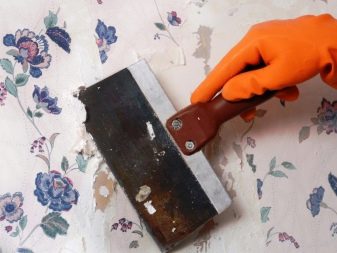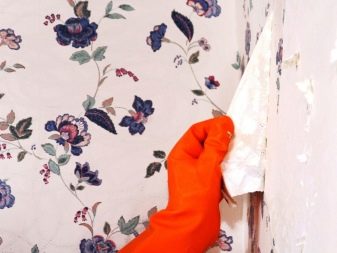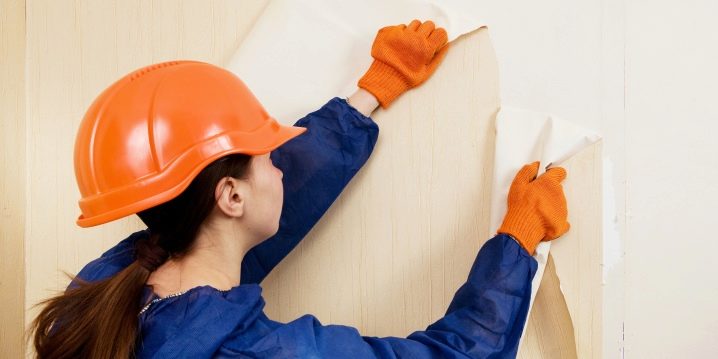Wallpaper remover: which one to choose?

Wallpaper is a versatile decorative material that is used for interior wall decoration. One of its disadvantages is its limited service life, which requires consistent replacement of the entire coating. Dismantling these canvases is not always easy.

Wallpaper removers will greatly speed up and facilitate the process. With their help canvases can be removed in a short time with minimal effort.

Specifications
Wallpaper strippers are only used on surfaces to which the adhesive has adhered very well. Today there are many fluids that can be used to solve this problem. These formulations are versatile and are suitable for peeling both paper and vinyl products. But if you used liquid crystal wallpaper, then it is impossible to remove them using solutions.
To do this, you will need to use special sanders and apply heating to the surface of the walls in order to weaken the adhesion between the materials.

Almost all types of adhesives are composed of organic components. Therefore, to remove old wallpaper from the walls, you should use substances that dissolve such mixtures. It should be noted that liquids for removing such materials are very similar in structure to conventional detergents.
Therefore, many use the latter to prepare solvents at home.

Solvents are made up of several components:
- Defoamers.
- Surfactant.

These compounds not only quickly dissolve the glue under the wallpaper, but also penetrate very well into the structure of the canvases themselves.
Several advantages of such fluids should be highlighted:
- The mixtures are completely safe for human health, since they do not contain toxic components. But at the same time, chemicals are still present here, so they can accumulate on the surface of the walls over time.
- Preparation of a solution is a fairly simple procedure, since all components dissolve easily in water.
- Substances do not burn or melt, which eliminates the risk of accidental fire.
- The solutions are completely hypoallergenic, which allows them to be used in almost any room in the house.
- The products practically do not interact with other finishing materials. But when using some species, it is still better to prevent them from getting on the surface of other substances.
- Relatively low cost. Therefore, almost everyone can afford such a composition.
- No smell. These mixtures give off aromas that are present in conventional laundry detergent or detergent.
Wallpaper removers may still differ in composition. Therefore, it is important to consider it when choosing such products.


Application
Removing old wallpaper is only necessary for the purpose of replacing it with new models. Today, the most common way to dismantle them is by wetting.
This process can be described in several sequential steps:
- Initially, a solution is prepared. Its composition is selected, depending on the type of wallpaper. Often, manufacturers produce mixtures for both paper and non-woven materials. But for the latter option, you will need to use a liquid with a higher concentration of active substances. Therefore, before cooking, be sure to read the instructions, where the exact ratios of water and the acquired composition are written.

- So that the active substances dissolve the glue quickly, you need to make several holes on the surface of the paper... This will allow the liquid to seep into the lower layers faster. Today, special toothed rollers are used for such damage, which simply cut and tear the wallpaper material. But if this is not the case, then you can make many holes with an ordinary knife.
The main thing is to simply damage the top layer of the material to allow water to penetrate.

At this stage, you need to moisten the surface of the wallpaper. This can be done with a regular brush or spray bottle. The latter option is very rare in everyday life, since it is not always available.
To prevent the mixture from getting on the decoration and other products, they must be closed or taken out of the room.

- The procedure ends by removing the sheets. Please note that this should be done only after a certain time after wetting. Otherwise, you will be able to remove only those pieces that are moistened, leaving dry segments on the wall. It is best to do this with a spatula or knife, which simply pry the corners and remove the paper with your hands.
If the canvases are torn to pieces, then after removing the piece, you need to try again to wet the paper and leave. In order not to wait, you can simply remove the wallpaper from other parts of the wall.


The algorithm described earlier is suitable for almost all types of wallpapers and surfaces. If the products are glued to drywall, then you should very carefully wet it. This is necessary so as not to damage the paper frame, which keeps the sheet intact.

If there are special paintable wallpapers on the walls or materials that are glued to the bustilate, then it is almost impossible to remove them with the help of solutions. For this, either heating or mechanical grinding of the wall should be applied, which requires significant effort and time. But such approaches are quite rare today, since everyone is trying to use only safe adhesives for installation work.

How to choose?
Wallpaper removers are very widespread today, which has led to the emergence of many varieties. But almost all of them consist of similar components that are simply mixed in different concentrations. When choosing products, it is important to pay attention not only to what wallpaper they are intended for, but also to their manufacturer.

Ready-made purchased
Wallpaper manufacturers today offer several types of compositions for removing them.
The use of such products has several advantages:
- The composition of the mixture is fully suitable for a certain type of glue and materials. This eliminates the risk that it will not work, as in the example with homemade solutions.
- It only takes a few minutes to prepare the liquid, which speeds up repair work.

There are several types of such products on the market, among which several brands can be distinguished:
- Methylane (Metylan). The products of the German company Henkel are the most popular in the domestic market. Differs in reliability and high-quality interaction with all types of wallpaper.
- Axton. The main component here is a nonionic surfactant in the aqueous phase. After application, the rest of the mixture can not be washed off.
- Quelyd. The products of the French company allow you to work not only with different types of wallpaper, but even with several of their layers. The mixture is characterized by low consumption and high efficiency.
- Kleo and many other means.

But the popularity of the products leads to the appearance on the market of many fakes and cheap analogs. Therefore, experts recommend buying such products only at trusted retail outlets. As for manufacturers, only customer reviews are the best indicator of quality.
Therefore, try to pay attention to them so that you are not deceived and slipped with ordinary soapy water.

DIY cooking
Mixtures for removing wallpaper do not differ in a complex component structure.Almost all formulations include plain water and several chemical solvents. Today, craftsmen prepare similar mixtures at home.
There are many recipes, among which there are several main ones:
- For the solution, you need vinegar and warm water. The components should be diluted in several basic ones: proportions 1: 8, respectively. When the mixture is obtained, it can be safely applied to the surface of the wallpaper.

- Hot water and fabric softener. The percentage of the components should be approximately 2 to 1. After that, the resulting solution must be applied to the wallpaper using a spray gun. It is advisable to wait about 20-25 minutes before dismantling.

- Washing powder and hot water. For one serving, you will need 1 kg of the mixture and 10 liters of liquid. Before starting processing, you need to mix the components. It is important here that the powder is completely dissolved. After that, also using a spray gun or a sponge, apply the mixture to the wallpaper.

Please note that if you apply solutions with a regular brush, then you must adhere to safety rules. This is especially important when using hot water, which can easily damage the skin.
When using traditional methods, experts recommend following a few simple recommendations:
- Prepare solutions only with clean water that does not contain other impurities.
- After that, it is better to remove the wallpaper with a spatula.
- When the walls are cleaned, then it is imperative to wash off the remnants of the solution and powder that it contained.

General conclusions
Wallpaper remover is one of the options for quickly removing wallpaper. But it should be understood that many types of paper-based material can be easily removed even with ordinary water and a scraper.
Therefore, before purchasing specialized tools, you should try to see if this can be done without additional costs.

But if the wall surface is characterized by high-quality adhesion to wallpaper, then special solvents are the best solution for removing them. But it is important to take into account not only the structure and composition of the wallpaper, but also the type of base on which they are glued. Therefore, after analyzing all the parameters, you can choose high-quality products that will cope with almost any type of wallpaper.

In more detail about what tools will help you quickly remove old wallpaper, the following video will tell.













The Polyfilla wallpaper remover made the process easier, they removed everything without any problems.
The comment was sent successfully.